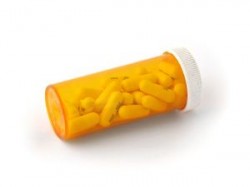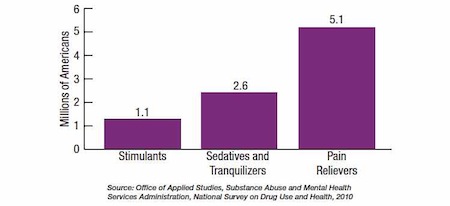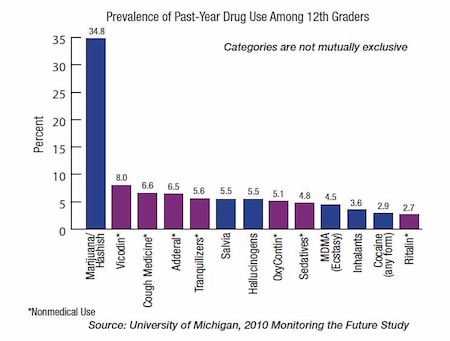Most Addictive Prescription Drugs. Opiate Abuse and Addiction.
 Medications can be effective when they are used properly, but some can be addictive and dangerous when abused. This chart provides a brief look at some prescribed medications that—when used in ways or by people other than prescribed—have the potential for adverse medical consequences, including addiction.
Medications can be effective when they are used properly, but some can be addictive and dangerous when abused. This chart provides a brief look at some prescribed medications that—when used in ways or by people other than prescribed—have the potential for adverse medical consequences, including addiction.
In 2010, approximately 16 million Americans reported using a prescription drug for nonmedical reasons in the past year; 7 million in the past month.
| Name | Examples of Commercial & Street Names | DEA Schedule | How Administered* |
|---|---|---|---|
| Barbiturates | Amytal, Nembutal, Seconal, Phenobarbital; barbs, reds, red birds, phennies, tooies, yellows, yellow jackets | II, III, V | injected, swallowed |
| Benzodiazepines | Ativan, Halcion, Librium, Valium, Xanax; candy, downers, sleeping pills, tranks | IV | swallowed |
| Sleep Medications | Ambien (zolpidem), Sonata (zaleplon), Lunesta (eszopiclone); forget-me pill, Mexican Valium, R2, Roche, roofies, roofinol, rope, rophies | IV | swallowed, snorted |
Intoxication Effects – Sedation/drowsiness, reduced anxiety, feelings of well-being, lowered inhibitions, slurred speech, poor concentration, confusion, dizziness, impaired coordination and memory
Potential Health Consequences – lowered blood pressure, slowed breathing, tolerance, withdrawal, addiction; increased risk of respiratory distress and death when combined with alcohol
Also, for barbiturates – euphoria, unusual excitement, fever, irritability/life-threatening withdrawal in chronic users
| Name | Examples of Commercial & Street Names | DEA Schedule | How Administered* |
|---|---|---|---|
| Codeine | Empirin with Codeine, Fiorinal with Codeine, Robitussin A-C, Tylenol with Codeine; Captain Cody, Cody, schoolboy; (with glutethimide: doors & fours, loads, pancakes and syrup) | II, III, V | injected, swallowed |
| Morphine | Roxanol, Duramorph; M, Miss Emma, monkey, white stuff | II, III | injected, swallowed, smoked |
| Methadone | Methadose, Dolophine; fizzies, amidone, (with MDMA: chocolate chip cookies) | II | swallowed, injected |
| Fentanyl & analogs | Actiq, Duragesic, Sublimaze; Apache, China girl, China white, dance fever, friend, goodfella, jackpot, murder 8, TNT, Tango and Cash | II | injected, smoked, snorted |
| Other opioid pain relievers: Oxycodone HCL, Hydrocodone Bitartrate Hydromorphone, Oxymorphone, Meperidine, Propoxyphene | Tylox, Oxycontin, Percodan, Percocet: Oxy, O.C., oxycotton, oxycet, hillbilly heroin, percs Vicodin, Lortab, Lorcet; Vike, Watson-387 Dilaudid; juice, smack, D, footballs, dillies Opana, Numporphan, Numorphone; biscuits, blue heaven, blues, Mrs. O, octagons, stop signs, O bomb Demerol, meperidine hydrochloride; demmies, pain killer Darvon, Darvocet |
II, III, V | chewed, swallowed, snorted, injected, suppositories |
Intoxication Effects – Pain relief, euphoria, drowsiness, sedation, weakness, dizziness, nausea, impaired coordination, confusion, dry mouth, itching, sweating, clammy skin, constipation
Potential Health Consequences – slowed or arrested breathing, lowered pulse and blood pressure, tolerance, addiction, unconsciousness, coma, death; risk of death increased when combined with alcohol or other CNS depressants
Also for fentanyl – 80-100 times more potent analgesic than morphine
Also for oxycodone – muscle relaxation/twice as potent analgesic as morphine; high abuse potential
Also for codeine – less analgesia, sedation, and respiratory depression than morphine
Also for methadone – used to treat opioid addiction and pain; significant overdose risk when used improperly
** Taking drugs by injection can increase the risk of infection through needle contamination with staphylococci, HIV, hepatitis, and other organisms. Injection is a more common practice for opioids, but risks apply to any medication taken by injection..
| Name | Examples of Commercial & Street Names | DEA Schedule | How Administered* |
|---|---|---|---|
| Amphetamines | Biphetamine, Dexedrine, Adderall; bennies, black beauties, crosses, hearts, LA turnaround, speed, truck drivers, uppers | II | injected, swallowed, smoked, snorted |
| Methylphenidate | Concerta, Ritalin; JIF, MPH, R-ball, Skippy, the smart drug, vitamin R | II | injected, swallowed, snorted |
Intoxication Effects – Feelings of exhilaration, increased energy, mental alertness
Potential Health Consequences – increased heart rate, blood pressure, and metabolism, reduced appetite, weight loss, nervousness, insomnia, seizures, heart attack, stroke
Also, for amphetamines – rapid breathing, tremor, loss of coordination, irritability, anxiousness, restlessness/delirium, panic, paranoia, hallucinations, impulsive behavior, aggressiveness, tolerance, addiction
Also, for methylphenidate – increase or decrease in blood pressure, digestive problems, loss of appetite, weight loss
| Name | Examples of Commercial & Street Names | DEA Schedule | How Administered* |
|---|---|---|---|
| Dextromethorphan (DXM) | Found in some cough and cold medicines; Robotripping, Robo, Triple C | Not scheduled | swallowed |
Intoxication Effects – Euphoria, slurred speech
Potential Health Consequences – increased heart rate and blood pressure, dizziness, nausea, vomiting, confusion, paranoia, distorted visual perceptions, impaired motor function
Facts About Prescription Drug Abuse
 About 7 Million Americans Reported Past-Month Use of Prescription Drugs for Nonmedical Purposes in 2010
About 7 Million Americans Reported Past-Month Use of Prescription Drugs for Nonmedical Purposes in 2010What types of prescription drugs are abused?
Three types of drugs are abused most often:
- Opioids—prescribed for pain relief
- CNS depressants—barbiturates and benzodiazepines prescribed for anxiety or sleep problems (often referred to as sedatives or tranquilizers)
- Stimulants—prescribed for attention-deficit hyperactivity disorder (ADHD), the sleep disorder narcolepsy, or obesity.

How can you help prevent prescription drug abuse?
- Ask your doctor or pharmacist about your medication, especially if you are unsure about its effects.
- Keep your doctor informed about all medications you are taking, including over-the-counter medications.
- Read the information your pharmacist provides before starting to take medications.
- Take your medication(s) as prescribed.
- Keep all prescription medications secured at all times and properly dispose of any unused medications.
Dependence vs. Addiction
Physical dependence occurs because of normal adaptations to chronic exposure to a drug and is not the same as addiction. Addiction, which can include physical dependence, is distinguished by compulsive drug seeking and use despite sometimes devastating consequences. Someone who is physically dependent on a medication will
experience withdrawal symptoms when use of the drug is abruptly reduced or stopped. These symptoms can be mild or severe (depending on the drug) and can usually be managed medically or avoided by using a slow drug taper.
Dependence is often accompanied by tolerance, or the need to take higher doses of a medication to get the same effect. When tolerance occurs, it can be difficult for a physician to evaluate whether a patient is developing a drug problem, or has a real medical need for higher doses to control their symptoms. For this reason, physicians need to be vigilant and attentive to their patients’ symptoms and level of functioning to treat them appropriately.
Opiate Withdrawal Symptoms and Treatment
Different types of medications may be useful at different stages of treatment to help a patient stop abusing drugs, stay in treatment, and avoid relapse.
Treating Withdrawal. When patients first stop abusing drugs, they can experience a variety of physical and emotional symptoms, including depression, anxiety, and other mood disorders; restlessness; and sleeplessness. See list here: opiate withdrawal symptoms and timeline. Certain treatment medications are designed to reduce these symptoms, which makes it easier to stop the abuse. There are also Natural Supplements that will help with withdrawal symptoms.
Staying in Treatment. Some treatment medications are used to help the brain adapt gradually to the absence of the abused drug. These medications act slowly to stave off drug cravings, and have a calming effect on body systems. They can help patients focus on counseling and other psychotherapies related to their drug treatment.
Preventing Relapse. Science has taught us that stress, cues linked to the drug experience (e.g., people, places,things, moods), and exposure to drugs are the most common triggers for relapse. Medications are being developed to interfere with these triggers to help patients sustain recovery.


















